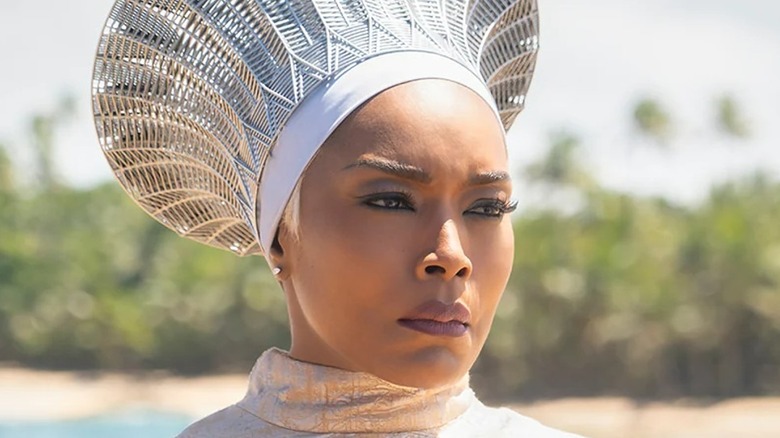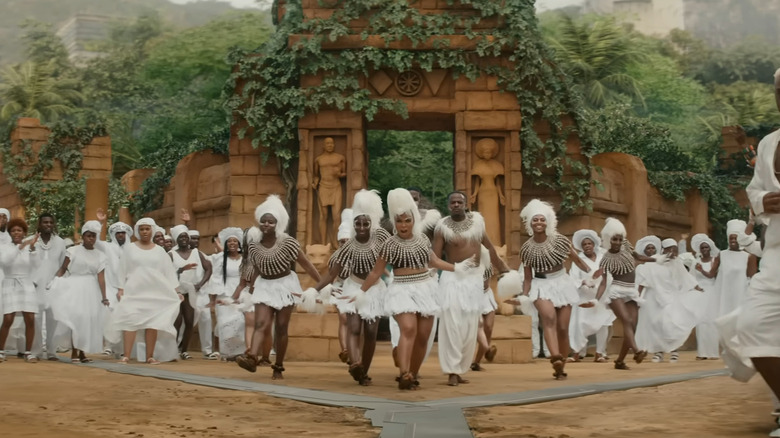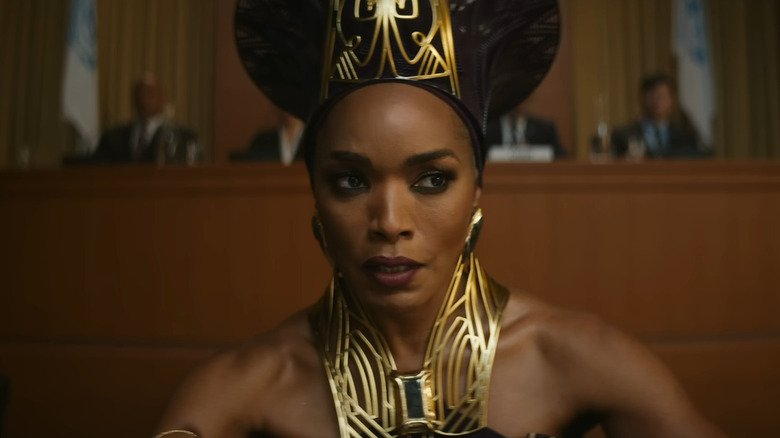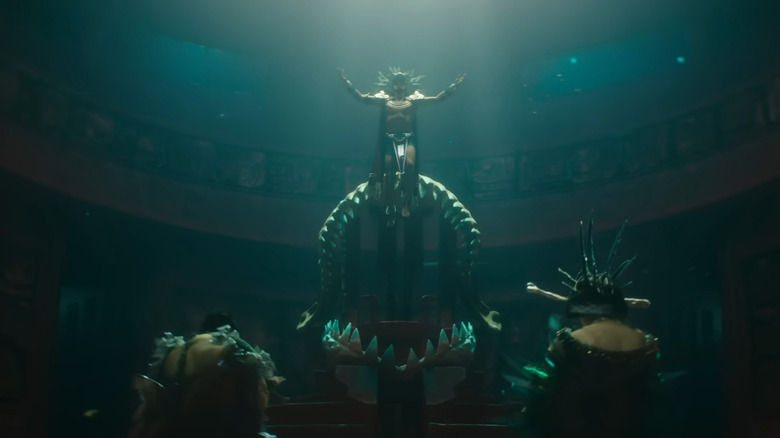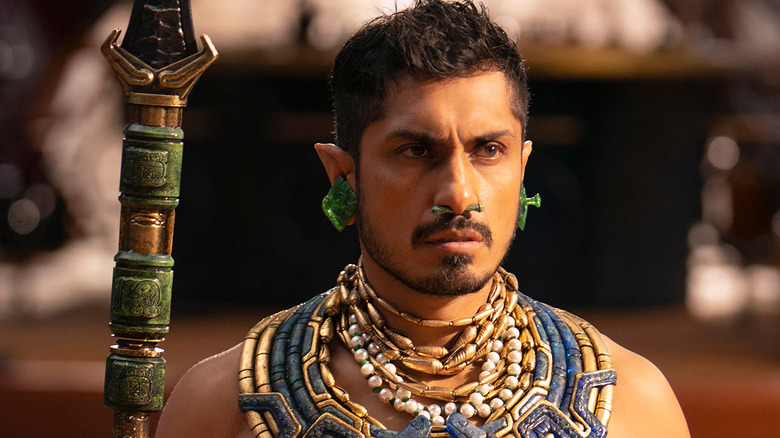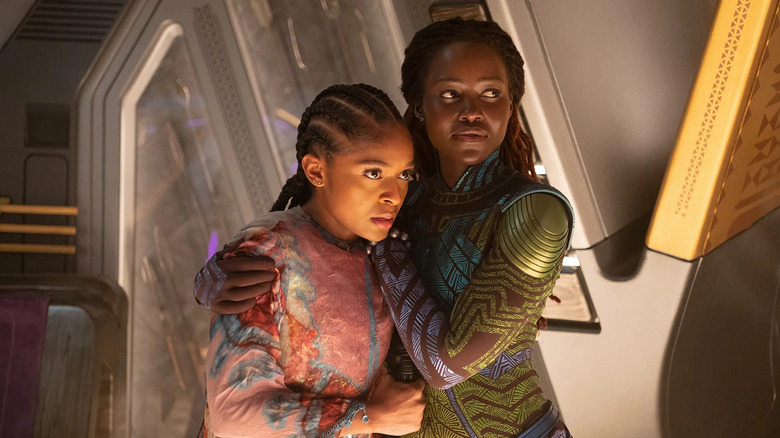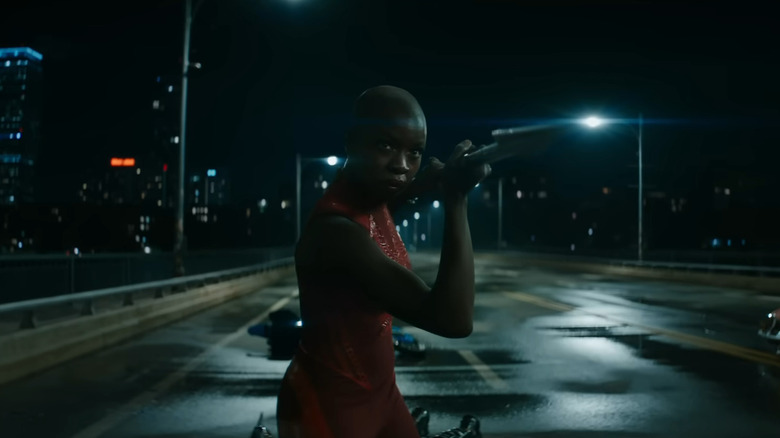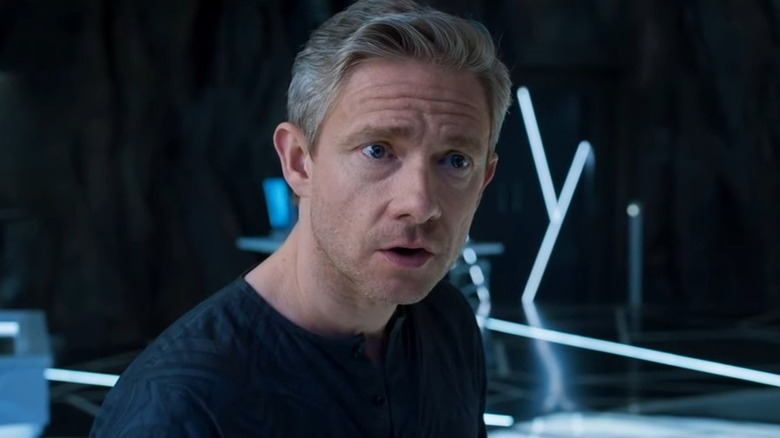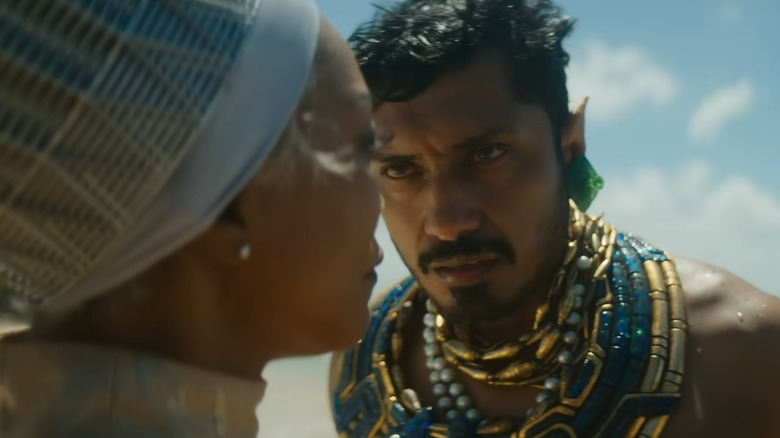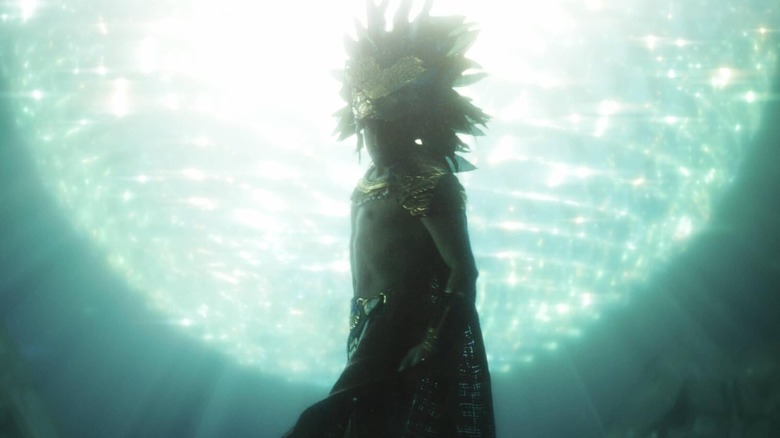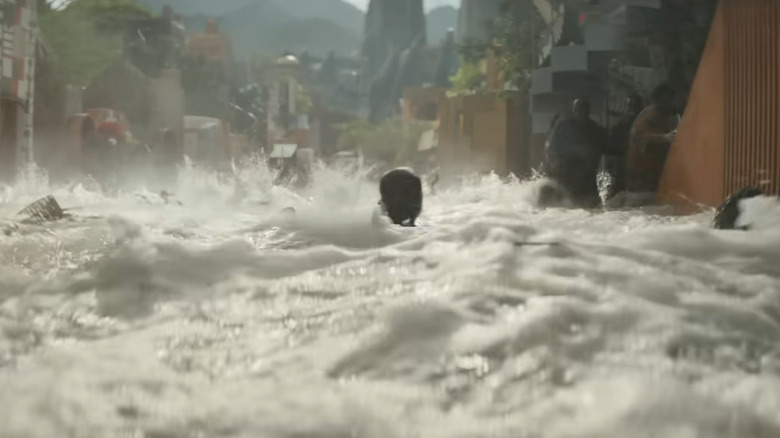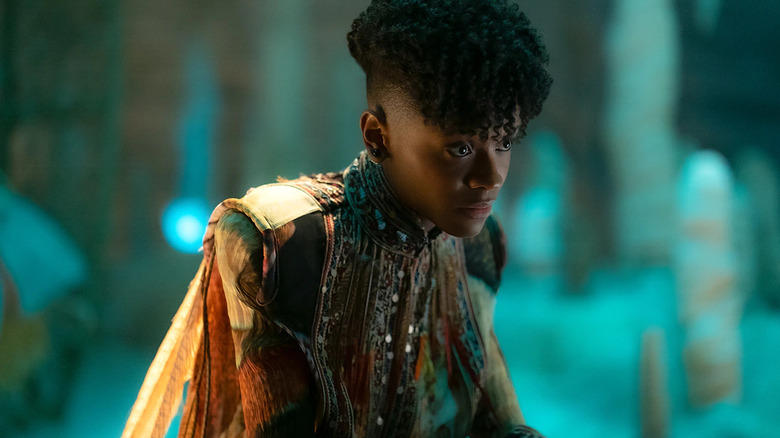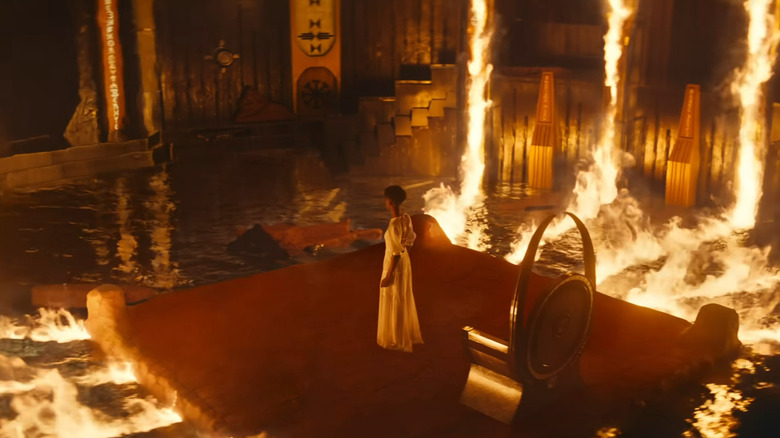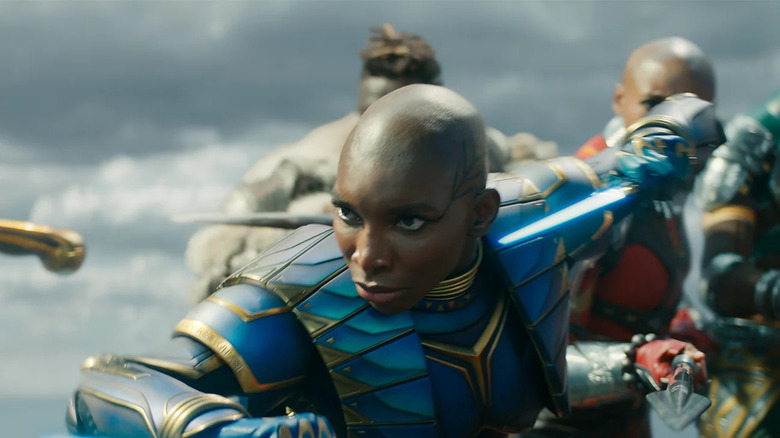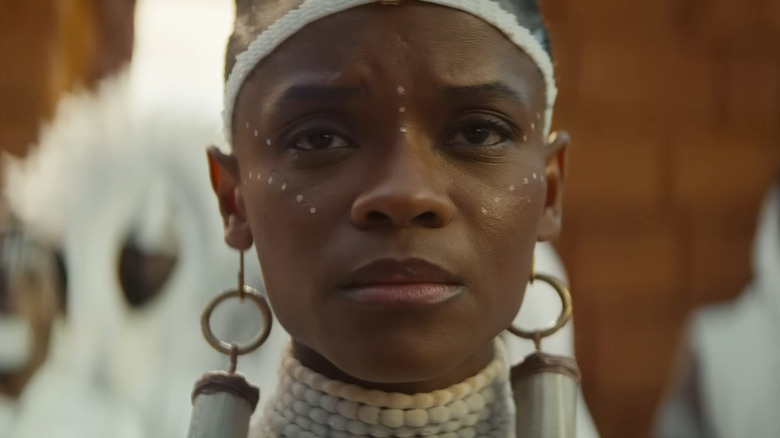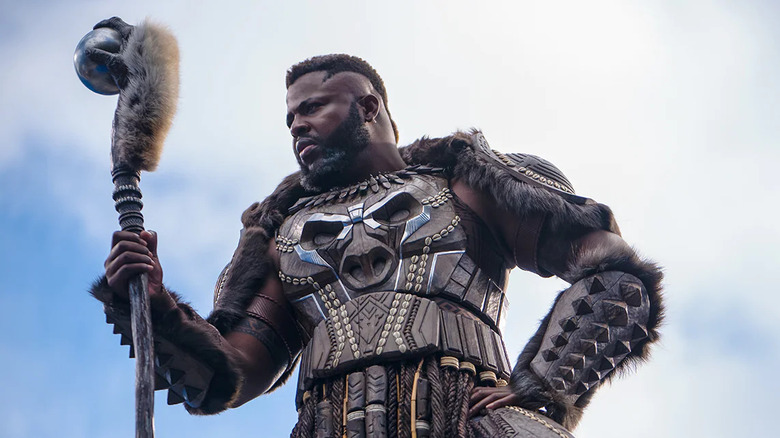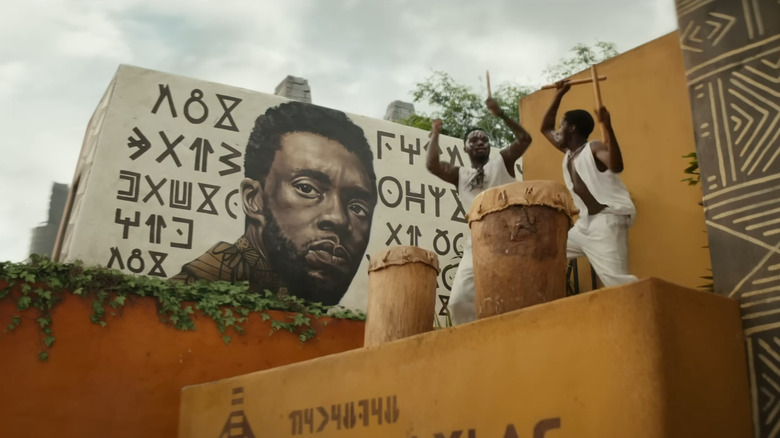Black Panther: Wakanda Forever's Most Confusing Moments Explained
"Black Panther: Wakanda Forever" is a true epic — a film packed with so many characters and storylines it barely fits within its 161 minutes. The sequel is many things at once. It's a mythical tale of clashing nations, a powerful tribute to the late Chadwick Boseman, and a story of all-consuming grief and, eventually, hope. For better or worse, it's also still part of the larger MCU, which means at least a few moments tie to the larger series.
In such a loaded movie, there are bound to be some confusing moments. "Wakanda Forever" doesn't have time to fully explain every superpower, plot twist, and piece of sci-fi tech. Nor does it have the luxury to overtly spell out every character motivation. Fortunately, director Ryan Coogler and the cast and crew do an admirable amount of heavy lifting via their subtext. The details and deeper meanings of "Black Panther 2" are there, just hidden a bit beneath the surface, like the subaquatic city of Talokan.
From several major character arcs to the introduction of an entirely new civilization, the film has a lot of ground (or, you know, water) to cover. Below, a (spoiler-heavy) breakdown of the most confusing moments in "Black Panther: Wakanda Forever."
The death of T'Challa
The impact of Chadwick Boseman's 2020 death is felt from the very beginning of "Wakanda Forever." The first scene — even before the traditional Marvel logo montage (which is itself altered to focus on Boseman) — shows Shuri (Letitia Wright) trying desperately to synthesize a cure for her brother's illness. The audience doesn't get much explanation for what actually happened to T'Challa, and a later news broadcast describes his disease as being mysterious.
The main action of the film takes place a year after T'Challa's death, itself occurring roughly five years after the Thanos "Infinity War" snap. This is clear because when Queen Ramonda contacts Nakia (Lupita Nyong'o) in Haiti, she's been gone from Wakanda for six years. This is to say, it's possible that T'Challa's mysterious illness had something to do with being brought back in the "Avengers: Endgame" blip, given the timing. However, the film isn't really interested in making such connections. Instead, it treats T'Challa's passing as a mirror of Boseman's own, blurring the lines between real-world and in-universe mourning in a powerful, deeply affecting way.
Like his "Black Panther" character, Boseman died from an illness that he chose to keep secret from the world at large. Speaking with The Hollywood Reporter in 2020, Boseman's agent Michael Greene said that he intentionally kept his colon cancer and treatments private because he "did not want to have people fuss over him." Later in "Wakanda Forever," Shuri mentions that her brother "suffered in silence" for a long time.
Queen Ramonda's speech
A year after the death of T'Challa, "Wakanda Forever" jumps to a meeting of international leaders. Some of Earth's less admirable political powers are frustrated with their lack of access to Wakanda's vibranium reserves and advance technology. Queen Ramonda (Angela Bassett) enters and delivers a cutting speech about how most nations can't be trusted, intercut with a scene of an undesignated strike team infiltrating a Wakandan facility and getting absolutely wrecked by the Dora Milaje. Okoye (Danai Gurira) then bursts into the meeting with the captured strike team in tow, depositing them in front of the French representative.
The implication here seems to be that the strike team was French military, sent to a Wakandan outpost outside of Wakanda to steal vibranium. However, the exact details aren't specified. Ramonda says that any further efforts to steal vibranium will be seen as acts of war, but it honestly feels a little strange that a single coordinated attack isn't enough to push her to more drastic measures.
One of the recurring themes in the "Black Panther" sequel is the relationship between vengeance and wellbeing in a community. M'Baku (Winston Duke) later tells Shuri that her mother wouldn't have wanted her to drag Wakanda into war to avenge her death, which makes this early moment of Ramonda showing mercy much more significant. She always considers the toll her actions could take on her people, which is something Shuri must learn to do as well.
The Talokanil's first attack
The Talokanil reveal themselves in striking fashion at the beginning of "Black Panther: Wakanda Forever." The film jumps to a secret US deep-sea mining operation in the middle of the ocean that is using new technology to search for vibranium. When a pair of divers goes down to investigate a potential find, however, the whole mining rig is ambushed by a squad of Talokanil, led by Namor (Tenoch Huerta) — the first Marvel character ever created (well, technically, it's a tie).
One thing in this sequence never fully explained is the hypnotic tune used by the Talokanil to lure soldiers into the sea. Once the music starts, the guards stationed on the platform start dropping into the ocean one by one, seemingly robbed of their freewill. It is subsequently explained that sonic communication is integral to the culture and structure of Talokan, which makes sense given how common echolocation is in aquatic animals. The dangerous "sonic attack" that lures these soldiers to their watery mass grave is never explicitly explained, but it has its roots in the common mythology of siren songs, supposedly used by mermaids to attract prey.
Lastly, there's an interesting detail included right before the Talokanil attack. While underwater, one of the divers sees a massive, red phantom jellyfish. Presumably, the creature was summoned by Namor to serve as a distraction, but its inclusion is particularly interesting given that Namor is later compared to a jellyfish by Shuri. His method of extracting oxygen from water is quite similar, and the appearance of the jellyfish can therefore be read as a subtle foreshadowing.
Namor's introduction
Viewers first see Namor when he attacks the ocean mining platform, but don't formally meet him until a later scene, where he introduces himself to Shuri and Queen Ramonda. The two are having a quiet moment on the bank of a river, discussing their grieving for T'Challa, when Namor spooks some elephants and emerges from beneath the water, levitating on his cool ankle wings. The Queen is shocked that he was able to get past Wakanda's defenses, presumably just by swimming up-river the whole way from the sea. What's harder to explain is how he manages to get the vibranium detector — a massive machine — onto the shore next to them unnoticed.
Clearly, Namor didn't come up-river alone. He must have had a crew in tow — likely, the same later seen attacking Shuri, Okoye, and Riri (Dominique Thorne). Nevertheless, the only way the Talokanil could have possibly removed the machine from the water so quickly and quietly is with immense strength and superb stealth — traits they show off numerous times, later in the film. The depositing of the machine is essentially an intimidation tactic, showing the queen and princess just how easily Namor and his followers could sneak into Wakanda whenever they choose.
Riri's warehouse
One of the great new additions to the MCU in "Black Panther: Wakanda Forever" is Riri Williams (AKA Ironheart). A teenage genius who builds a vibranium locator for a school project, Riri becomes a target of both Namor and the United States government. When Shuri and Okoye intervene to help her, the all wind up at a massive warehouse, which essentially functions as Riri's lab.
How does she manage to afford all her gear, let alone the rent for this warehouse? Well, for one, Riri is clearly a hustler. Her introductory scene shows her getting majorly paid for helping other MIT students — many of whom are loaded with family money — with their homework. She later says that she's been building things since she was 3 years old, so it's not hard to imagine her affording something like a secret lab on the merits of her talent and drive.
Of course, the most interesting feature of the warehouse is the DIY Iron Man (or, rather, Ironheart) suit that Riri says she's been working on for years. She mentions in passing that there's a whole sect of the internet, complete with YouTube videos, dedicated to the kind of garage-build super suit that she's managed to craft. Given how many years it's been since Tony Stark first took flight, it makes total sense that such an indie scene would exist. Of course, it's doubtful that anyone else has achieved the results Riri has.
Okoye's duel with the Talokanil
After an action-packed escape from the FBI, Shuri, Okoye, and Riri are targeted by a squad of Talokanil. With the other two women out cold, Okoye does her best to fight the attackers off, and she makes short work of most of them, delivering a few seemingly fatal blows. However, her opponents aren't quite as devastated as they seem. The warrior Attuma (Alex Livinalli) is the only one left standing at a point, but all it takes from him is another call to arms, and the other Talokanil rise up again.
The way they stand up makes it look like something supernatural is happening, but this is never confirmed. In reality, it's probably just a mark of how much stronger Talokanil are than regular humans, even while fighting on land. Of course, it helps that they're all decked out in vibranium gear — though that shouldn't be enough to save you from a spear through the belly.
Ross and Val
The main MCU Phase Four connection in "Black Panther: Wakanda Forever" is Contessa Valentina Allegra de Fontaine (Julia Louis-Dreyfus), who shows up in her new role as director of the CIA. Since she's now boss to Everett Ross (Martin Freeman), she becomes a constant thorn in his side as he tries to subtly help the Wakandans and delay U.S. activity. However, Val is a couple steps ahead of him, and she ends up catching him in his treasonous act.
The most confusing thing about these two, however, is that they're ... apparently exes? Val has a throwaway line about apologizing to Ross for some things she said and did during their marriage, and she flirts with him aggressively. In the comics, Val has an extended romantic relationship with Nick Fury, and often makes some plays at Captain America as well, so there's certainly precedent for her having notable former flames. Still, this dynamic with Ross is a bit surprising.
Namor's origin story
After volunteering to travel to Talokan with Riri, Shuri gets a chance to properly get to know Namor. His story, augmented by a series of flashbacks, is fascinating in part because of how closely it mirrors Wakanda's own.
Namor's people — a Mesoamerican group from the Yucatan Peninsula — were decimated by smallpox and other dangers brought by Spanish invaders in the late 16th century. Prayers to one of their gods led them to a strange plant that, when eaten, brought about a powerful transformation. The people who ate it saw their skin turn blue and felt their lungs turn to gills, forcing them into the water to survive. Namor himself was born a "mutant" — a term that the film does not overtly connect to the "X-Men" story — after his mother ingested the strange plant while pregnant with him. As a result, he was born with wings on his ankles and pointed ears, as well as the ability to breathe both underwater and in the air. He's also implied to be immortal — at the very least, he can live a very long time.
There are a number of fascinating details here, quickly glossed over. While different from the Heart-Shaped Herb, the plant found by the Talokanil is also the product of "vibranium-rich soil," according to Shuri. And just like how a prayer to the Wakanda goddess Bast led to the discovery of vibranium, so too did a deity help the Talokanil reach salvation. Why the plant transformed Namor's people in such a specific way is unclear, but it hints at an even larger mythology around vibranium.
A tour of Talokan
After being filled in on Namor's origin story, Shuri is taken on a tour of Talokan. Viewers don't get to spend much time in the gorgeous underwater city, but there are a lot of interesting details that help add dimension and context for Namor's people and their society. At the center of the city is a massive pyramid-like temple, which Shuri quickly recognizes it as being made of vibranium. Out of this temple emerges a ball of light that illuminates the entire city. "From the bottom of the ocean, I brought the sun to my people," Namor says with pride.
What exactly is this strange device? How does it work? What is its purpose? Such questions aren't given much explanation, but a look at Wakanda's own vibranium-based technology offers ideas. While vibranium is most famous in its solidified metal form, it is also a powerful energy source. Wakanda's ships and advanced technology all take their power from vibranium. With that in mind, it's not hard to envision someone like Namor being able to create a synthetic sun utilizing the same kind of technology, as vibranium has very few known limitations in the MCU canon.
It is also worth noting that the local Talokanil don't appear blue when under water. Namor is never blue, but his warriors take on a blue hue when fighting above the surface. This shift may be due to some unexplained by-product of their transformation.
The flooding of Wakanda
For the first half of "Wakanda Forever," it looks like war might not break out between the Wakandans and the Talokanil. However, all hopes of a peaceful resolution to their dispute are destroyed when Nakia kills the two guards holding Riri and Shuri. Namor wastes no time gathering his forces and infiltrating Wakanda; the manner with which he attacks, however, is clouded.
Seemingly out of nowhere, the streets of the capital city begin to flood. Entire streets and districts are submerged in the deluge almost instantaneously, and Talokan warriors follow in the wake. Where is all this water coming from? Well, fortunately for Namor, the city is built along some major waterways. It seems that the Talokanil break some barriers at the start of their attack, allowing the flooding to begin, and they amplify that flooding with an arsenal of their own water bombs, glimpsed in several scenes throughout the film. The flooding is necessary so that the Talokanil can fight at full strength; it's an easy way to destabilize their foes.
Of course, the main impact of Namor's invasion is the death of Queen Ramonda. The entirety of the attack occurs because Wakanda, under her leadership, refuses to end an innocent life. After the throne room is flooded, viewers see Ramonda make a choice. She could have escaped and left Riri to die, but then, what would have been the point? Instead, she chooses to save Riri — someone with which she is barely acquainted — knowing full well she may die for it. But that's just the kind of queen Ramonda has always been.
Rebuilding the heart-shaped herb
After her mother dies, Shuri plunges even more deeply into grief and rage. Her earlier claims that she wants to "burn the whole world" begin to feel powerfully real, and it becomes clear that "Wakanda Forever" is her story, more so than anyone else. In the interest of vengeance, she resumes her work trying to synthesize a new heart-shaped herb, this time using a combination of her brother's DNA and the vibranium-rich fibers in the bracelet Namor gave her.
The idea here, essentially, is that with enough understanding of how vibranium works, the effect it has on plant life, and the effect the herb has on the human body, Shuri is able to replicate the effect. And that's exactly what she manages to do with some help from Riri. Could Shuri have recreated the heart-shaped herb without Namor's gift, had she been given the motivation before? It's possible. The film leaves ambiguous how much of Shuri's success is due to new information, and how much is the result of the fire already lit within her.
The return of Killmonger
When Shuri ingests the heart-shaped herb, Nakia asks that her mother meet her on the ancestral plane. It would make sense for Queen Ramonda to be the one waiting for her, as T'Challa was met by their father when he first journeyed there. But the person waiting for Shuri isn't exactly the one she expects to find.
Instead of her mother, it's Erik Killmonger (Michael B. Jordan) who greets her, seated on a Wakandan throne surrounded by flames. He encourages Shuri to embrace the rage within her; to take all the power she can and strike back against the world that has hurt her so much. Apparently, it's this rage that brings her to Killmonger in the first place. Shuri admits that she never really believed the ancestral plane was real before, and that she only ingested the herb because she wanted enough strength to kill Namor.
The implication is that the herb can tell a person's intention, and adjusts their experience accordingly. Shuri certainly misses her mother, but she likely knows what M'Baku tells her later is true — that Ramonda wouldn't want her to go to war, even for her own sake. So instead, Shuri subconsciously seeks an "ancestor" who'd be more supportive of her bid for revenge. Killmonger fits that bill quite nicely.
The Midnight Angels and Ironheart
When Shuri goes into her final battle against Namor at the end of "Black Panther: Wakanda Forever," she doesn't do it alone. Obviously, M'Baku, the Dora Milaje, and some other Wakandan warriors join her mission to kill Namor, but she has three particularly strong allies thanks to some new super suits. Riri emerges in a new and improved Ironheart suit, and Okoye and Aneka (Michaela Coel) get their Dora skills maxed out with some new "Midnight Angel" suits.
Of course, Ironheart is a familiar character for fans of the comics, and the star of her own MCU series after "Wakanda Forever." But the Midnight Angels are also pulled from the comics. In the comics, they're the most elite members of the Dora Milaje, but they don't get the cool blue super suits that Shuri makes for them in the movie. All three of these suits seem to be hybrids of the old Black Panther suit, Tony Stark's later Iron Man models, and Shuri's own personal innovations. The end result is quite impressive, as the Talokanil quickly find out.
A tenuous peace
After a tense, action-packed battle, Shuri has the opportunity to kill Namor. She wants to avenge her mother, but it's bigger than that. She has channeled all her rage at the world — about her father's death, her brother's death, everything — into a hatred of Namor. But when she has the blade at his neck, she just can't go through with it.
She realizes all the ways in which Wakanda and Talokan are the same. She sees herself in Namor's people. And of course, she gets a soft hand on her shoulder from her mother, who appears to tell her not to go through with her revenge. It's not entirely clear whether this is truly Ramonda, channeled through the power of the heart-shaped herb, or if its simply a manifestation of Shuri's inner turmoil. But at the same time she sees her mother, Namor sees his.
It's possible that this is a truly mystical moment — the effects of vibranium-modified genes striking both characters at once and connecting them to their deceased parents. Regardless, they forge a peace out of it, albeit one that Namor makes with other intentions in mind. As he reveals to Namora (Mabel Cadena) at the end of the movie, he believes the rest of the world will come for Wakanda eventually. When they do, Shuri may be desperate enough to agree to Namor's plans for all-out war.
M'Baku's bid for the throne
With the dust settled from Wakanda's brief war with Talokan, Shuri goes on a little trip to see Nakia in Haiti. A Wakandan gathering in celebration of the new Black Panther gets a record-scratch moment when M'baku, not Shuri, descends from a ship and announces that the princess won't be joining them. He then announces his desire to make a bid for the throne — something he did unsuccessfully in the first "Black Panther," before being defeated and later embraced by T'Challa.
The scene cuts away before the audience can see how it will play out, leaving things a bit confusing. There is dialogue after Ramonda's death, where the elders mention their need to choose a new leader. Even after Shuri gains her powers and dons the Black Panther suit, she's still referred to as "Princess," not "Queen." Of course, the Wakandan throne is always up for grabs to those willing to fight for it, but Shuri isn't even present when M'Baku makes his bid. Maybe she has no desire to be Queen of Wakanda.
Or perhaps she's happy just being the Black Panther — protector of her people and all-around science wiz. It's possible that M'Baku is making a power play in her absence, but given his loyalty throughout the film, that seems unlikely. MCU fans will have to wait for Black Panther's MCU return to see how this whole situation plays out — but for now, it's clear Shuri is taking some time alone to process and heal, as her mother encouraged.
T'Challa's son
"Black Panther: Wakanda Forever" doesn't have a traditional MCU post-credits sequence, but there is a scene worth sticking around for after the first round of credits roll. As she watches her funeral clothes burn on the beach in Haiti, Shuri meets an unexpected stranger — the son of her late brother and Nakia, who bears his father's name.
How does this secret child exist? Presumably, he was conceived shortly before the "Infinity War" snap, as Nakia was present in Wakanda up until T'Challa was taken by Thanos. That would have allowed Nakia to leave for Haiti before anyone would have noticed that she was pregnant. It also would have meant that T'Challa wouldn't have met his son until he was 4 or 5, after the late king returned to life in "The Blip." Even after that, he and Nakia decided to keep their child a secret so that he might grow up having a normal childhood.
Nakia tells Shuri that T'Challa prepared her and their son for his death, and that Ramonda got to meet the boy. Presumably, this is what Ramonda wanted to tell Shuri about her brother on the night they met Namor. After an entire movie about the effects of grief, meeting the young T'Challa is a welcomed spark of hope. He's a reminder that family never really dies, and that the future can once again be bright.
